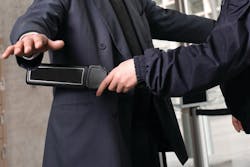School security plans should prepare students to expect the unexpected
School administrators have long feared an active shooter on campus. Now, they also have to consider and plan for the active slasher. Earlier this month, a high school sophomore armed with two large kitchen knives entered Franklin High School in suburban Pittsburgh and began stabbing and slashing students in crowded hallways. Before he was detained, 19 students and a security guard were injured.
Whether an attacker chooses to carry a gun, knife or other type of weapon, we have to find ways to keep potentially lethal weapons off our K-12 campuses. Incidents such as the one near Pittsburgh raise serious concerns and a question; how do we strike a balance between education and security without making our schools resemble a prison?
Although much focus is placed on preventing headline-grabbing attacks, we also have to be prepared for less serious incidents on campus as well. According to the National Center for Education Statistics, in 2011 the highest percentages of students most afraid of an attack or being harmed while at school were children between the ages of 12-18. That age group experienced 1,246,000 nonfatal victimizations (theft and violent crime) at school, compared to 965,200 nonfatal victimizations away from the campus.
Before taking any action, one of the most important steps administrators can take is to request a campus security assessment from a qualified security expert who can help design a full plan for securing the entire campus. Any plan will undoubtedly include technology, but no single technology can protect a K-12 campus. True protection comes from layers of security, ranging from locks to video intercoms to metal detectors. But that equipment also requires policies and procedures that ensure that the diverse components are being integrated and used most effectively.
A very effective plan that can be implemented is one that keeps students off balance or guessing what the security professionals have designed. That plan includes random searches of student lockers (within legal restrictions) and the use of police K-9 units to sniff for weapons and drugs in and around buildings and in parking lots. By keeping the landscape well-trimmed, we can also provide fewer hiding places for prohibited items.
When I was executive director of security for 150 Washington, D.C. public schools, I had access to walk-through and handheld metal detectors, which were purchased from Garrett Metal Detectors of Garland, Texas. While the detectors weren’t employed every day, my staff was fully trained on their use by the Garrett team. When we did use them, the kids were slightly delayed getting into the school, but we never experienced anything like the TSA lines encountered at airports.
The handheld metal detectors were very useful at sporting events and school dances, where we couldn’t risk allowing weapons in an already highly charged atmosphere.
While the searches and metal detectors uncovered many weapons and drugs, our seizures grew smaller as the school year progressed. The randomness of our activities left students so unsure of our plans that many students decided it wasn’t worth the risk of trying to sneak something on the campus.
Signs in the parking lot, at building entries and throughout the facility declared the campus a drug- and weapon-fee zone, making it clear that violators would be suspended, expelled and/or prosecuted. An anonymous tip line or website can also allow students and staff to share rumors before they become reality.
While fire drills are mandated in virtually every school district, it’s equally important that schools practice active shooter (or slasher) drills. Admittedly, they take time away from classroom instruction, but these drills can save lives and prevent injuries.
PA systems, phones, radios, duress buttons, fire alarms and other devices also can save lives during an emergency. Test them regularly to make sure they’re working when needed.
It’s also important to have school resource officers on a campus anytime staff and students are present. That can significantly trim police response time in emergencies, when every minute is critical.
And don’t forget surveillance cameras placed in and around school buildings. Cameras have proven to be a strong deterrent and very effective in helping to ensure policies and procedures are being followed, as well as providing evidence in forensic situations. They also provide a critical live insight for first responders during an emergency.
Even though school security has received greater attention since 1999’s Columbine massacre, it’s obvious we still need to do more. That 2011 survey also found that about seven percent of students reported being threatened or injured with a weapon, such as a gun, knife or club, while on school property. That’s unacceptable.
Security professionals, school administrators, teachers, parents and even students need to be willing to make changes. But those need to be intelligent changes that make use of the proper technology, policies and procedures – and even the element of surprise – to make our campuses safer and more secure.
About the Author: Patrick V. Fiel, Sr. is the founder of PVF Security Consulting. He has over 30 years of experience managing security and law enforcement organizations. He has served as the public safety advisor for a large security integrator, executive director of security for the Washington, D.C. Public School System, and is retired from the U.S. Army Military Police Corps. He can be reached at (910) 789-4265 or at [email protected].



